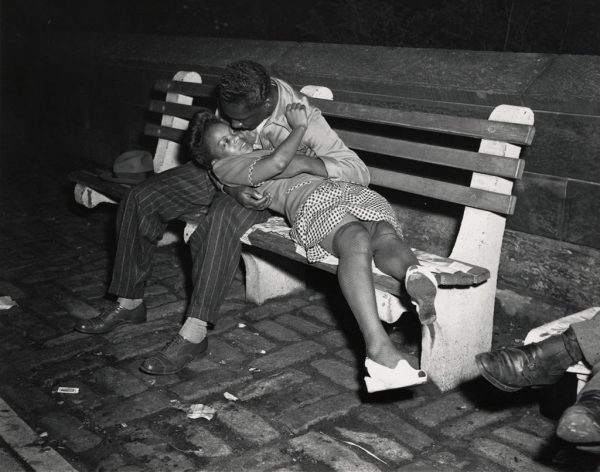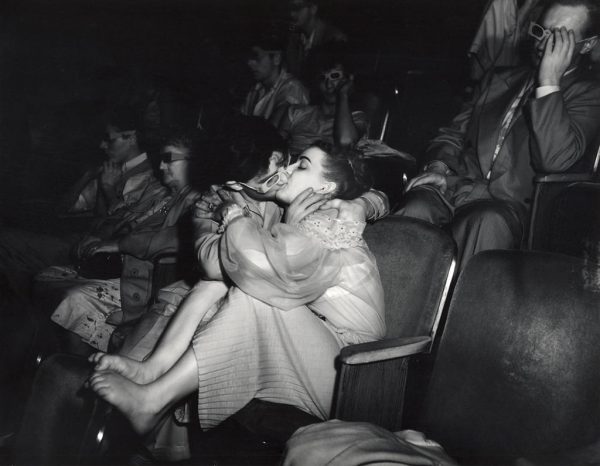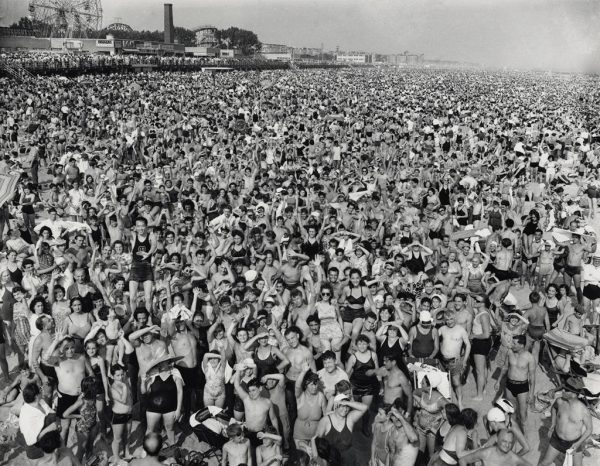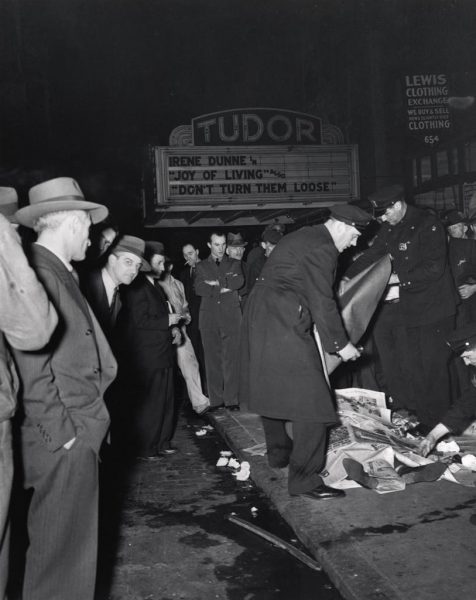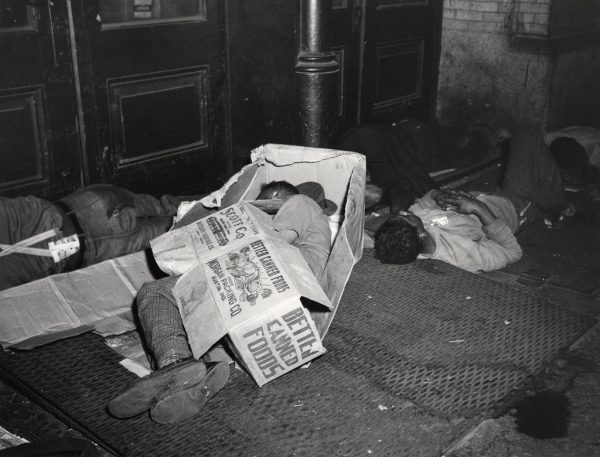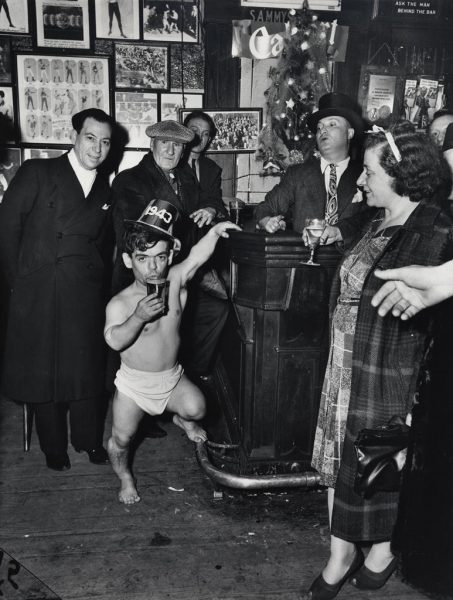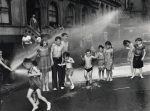Weegee
Weegee was the great photographer of New York in the 1930s, 1940s and 1950s, whose book Naked City helped to create the mythology of the city. “I have no inhibitions and neither does my camera…” – Weegee
Arthur Fellig acquired the name Weegee early in his career, a reference to the ouija board and his uncanny ability to arrive quickly at crime scenes – sometimes, even before the police (from 1937, he was the only civilian allowed to install a police radio in his car). Between 1940 and 1944 he worked on a retainer to PM newspaper, free to choose his own stories. He published Naked City in 1945, following it up the next year with Weegee’s People. He was fascinated by celebrity and promoted his own as Weegee the Famous. Naked Hollywood was published in 1953. He died in 1968. In 1981 Side Gallery organised the first UK tour of Weegee’s work, opening up a relationship between Amber and his widow Wilma Wilcox that lasted through until her death in the early 1990s. In 2008, Amber’s Pat McCarthy interviewed Sid Kaplan on Weegee – the celebrated New York photographer and printer had known him and had printed most of the Weegee photographs held in the AmberSide Collection. A transcript of that interview is available here.
For image usage rights please contact International Center of Photography, New York
Sid Kaplan interview
Weegee Collection
Text drawn from Side Gallery archive sources:
Arthur Fellig was born in Austria in 1899. Coming to the USA in 1909, he ended up in Manhattan’s Lower East Side. Leaving school in 1914 to help support the family, he worked for a time as a street photographer. In 1923 he joined Acme News Services as a darkroom operator. In 1935, he left to work as a freelance photographer. He acquired the name Weegee early on, a reference to the Ouija board and his uncanny ability to arrive quickly at crime scenes – sometimes, even before the police (from 1937, he was the only civilian allowed to install a police radio in his car).
From 1940 to 1944, Weegee worked on a retainer to PM newspaper, free to choose his own stories and making many of his best pictures in this period. 1945 saw an exhibition at the Museum of Modern Art and the publication of his best seller Naked City. The following year Weegee’s People was published. Opening up on the stories of New York: its streets, its bars and tenements, its crimes, tragedies and entertainments, he helped to shape urban America’s consciousness of itself, his images defining both the myth and reality of the city. Emerging as a national celebrity, he travelled to Hollywood, lecturing and photographing for Naked Hollywood (1953). He travelled widely and continued to work up until his death in 1968.
Note: In the process of arranging the first major UK exhibition and tour of Weegee’s work in the early 80s, Amber/Side Gallery began a relationship with his widow, Wilma Wilcox. When she died, she gave a major collection of his work to Amber. An A3 booklet exploring Weegee’s life, work and influence, published by Amberside in the 1980s, is available from the website.
Alternative text from Side Gallery archive:
He captured tenement infernos, car crashes, and gangland executions. He found washed-up lounge singers and teenage murder suspects in paddy wagons and photographed them at their most vulnerable – or, as he put it, their most human. He caught couples kissing on their beach blankets on Coney Island and the late-night voyeurs on lifeguard stands watching them. And everywhere he went, he snatched images of people sleeping: drunks on park benches, whole families on Lower East Side fire escapes, men and women snoring in movie theatres. He was the supreme chronicler of the city at night. He was the only shutterbug that would make it to a murder scene before the cops. Weegee loved New York and New York eventually loved Weegee.
Weegee was born June 12, 1899, in Austria, under the name Usher Fellig. Shortly after he was born his father left for America, where he was a Rabbi while saving enough money to send for the rest of his family. At the age of ten, Weegee with his mother and three brothers, finally arrived to America. At Ellis Island, Weegee’s name was changed from Usher to Arthur.
Early Life
As far as education, Weegee made it through the eighth grade. However, the family needed money and Weegee was needed to help work. He worked a lot of odd jobs: he helped his father with a push cart business, he even worked at a candy store for a while. It was when he had his picture taken by a street tintype photographer that he decided that this was what he was meant to do. Weegee often said that he was, ‘a natural-born photographer, with hypo in my blood.’ He quickly ordered a tintype outfit from a Chicago mail-order house, and after a few months he got his first job as a commercial photographer. After a few years he left the studio, due to a disagreement on what he should be paid. He then bought a second-hand 5×7 view camera and rented a pony from a local stable. He named the pony Hypo, and on the weekends when the kids were in their best clothes, he would walk around town putting kids on his pony and taking their picture. He would then develop the negatives, make prints, and go back to the families of the kids to try to sell them the photos.
Acme Newspictures
At the age of twenty-four, Weegee got his big break working for Acme Newspictures. Acme was the source for stock photos for their own paper and other papers around the country. Weegee started off working in the darkroom, developing other photographers’ work for the paper. Occasionally, when all the other Acme photographers were busy or sleeping, he would get to go out at night and take pictures of emergencies. After a few years of working for Acme, Weegee started to get called to do assignments and cover stories. This was what he always wanted; the only problem was that he worked for Acme, and thus, he never got credit for the photos he turned in. In 1935 he got tired of doing other peoples’ work and left Acme to go out and try to free-lance his own work. The girls around Acme gave him the name Weegee after the Ouija board. They said he always seemed to know where to be when a story broke.
Freelance Photographer
Weegee worked on his own as a freelance photographer for the next ten years. He started to work out of Manhattan Police Headquarters; he would arrive around midnight and check the Teletype machine to see if any stories had broke. After a few years he decided he didn’t want to wait for the news to come over the Teletype. He bought himself a 1938 Chevy Coupe and a press card, and he was allowed to have a police radio in the car (the only press photographer ever allowed to have a police radio in their car). Weegee’s car was his home away from home, his office on the road. In the trunk he kept everything he would need including a portable dark-room, extra cameras, flash bulbs, extra loaded holders, a typewriter, cigars, salami and a change of clothes.
I was no longer glued to the Teletype machine at police headquarters. I had my wings. I no longer had to wait for crime to come to me; I could go after it. The police radio was my life line. My camera… my life and my love… was my Aladdin’s lamp. – Weegee by Weegee, p52
After ten years he published his first book, The Naked City, which was inspired by the city he loved. It was during these ten years that Weegee produced some of his most expressive and beautiful photos.
Photographic Training
Weegee never had any formal photographic training. He had never heard of Alfred Stieglitz, Ansel Adams, or even the Museum of Modern Art. The work Weegee did came strictly from his heart. None of his photos were planned; his 4 x 5 speed graphic camera was preset at f/16 @ 1/200 of a second, with a focal distance of ten feet. All of his photos were taken at this setting with a flash. What photographic training Weegee may have needed to be a great photographer, he learned as he worked for Acme, or he just taught himself. Style, texture, or even quality of the photography did not matter much to Weegee. He was more concerned with capturing a moment of time on film. He recorded history as it happened. He had only a split second to capture the emotions of an event as they unfolded. A good example of this is the photograph of the Mother and Daughter crying as they watch another daughter and young baby burning to death inside a tenement fire. All that Weegee could really say about this photograph was, I cried when I took this picture.
In 1939, Weegee took a portrait of a mother and her son in Harlem. Even a photograph that Weegee would consider to be a portrait showed an incredible amount of emotion. With a snap of the shutter he told the story of this poor woman. The way he positioned her and her son behind the broken glass is representative of the shattered life she lived. Yet even with despair all around her, she still has a look of hope in her eyes, as if she were saying that she cannot give up. She has a sense of pride as she holds her son. This is the power and gift that Weegee had with a camera.
It is impossible to look at a work by Weegee and not get emotionally involved. That was the whole point to his photographs – he wanted the viewer to get involved. On one of the first stories Weegee had to cover, he was asked to get photos of a kid that was abandoned by its mother. In his autobiography Weegee stated, They (the cops) wanted pictures of the kid, so that the mother, seeing the picture in the papers, might become remorseful and come to claim the child. Weegee was ready to take a smiling picture when the nurse stopped him. The nurse stuck the baby with a pin, the kid started to cry and the nurse said, Now take a shot…This will bring the mother back. – Weegee by Weegee, p56. Luckily for the baby, this did bring the mother back. Weegee had a job to do – this was the way he made a living. He had to make pictures that the newspapers would want to buy, and the newspapers wanted drama.
Being a free-lance photographer was not an easy job during this point in history. Not a lot of people could make it as long as Weegee had. Even when things were going bad, Weegee had good spirits about it. He was always able to find happiness in whatever he was doing. He loved people, he loved photographing people, and he loved being with people. In his work he confronted murder, brutality, children in need, brawls, the homeless, fires and victims. He also confronted people who were happy, lovers, celebrations and the end of the War. Weegee’s work stands on its own – it’s meant to be viewed one at a time, not as a group. With each shot, Weegee captured a truth that can never be recreated.
Weegee died of a brain tumour on December 26, 1968. Today Weegee is credited with ushering in the age of tabloid culture, while at the same time being revered for elevating the sordid side of human life to that of high art.



